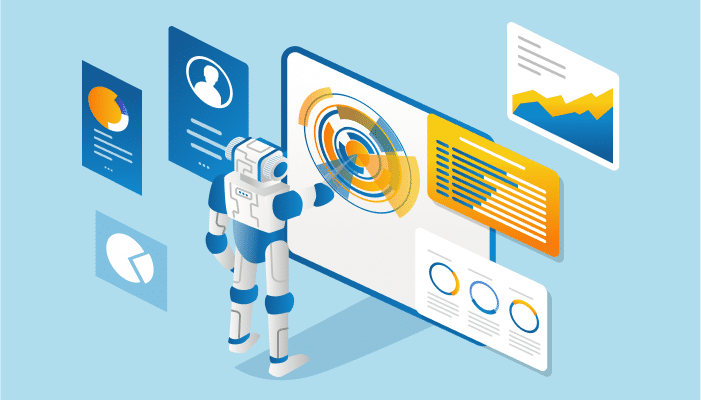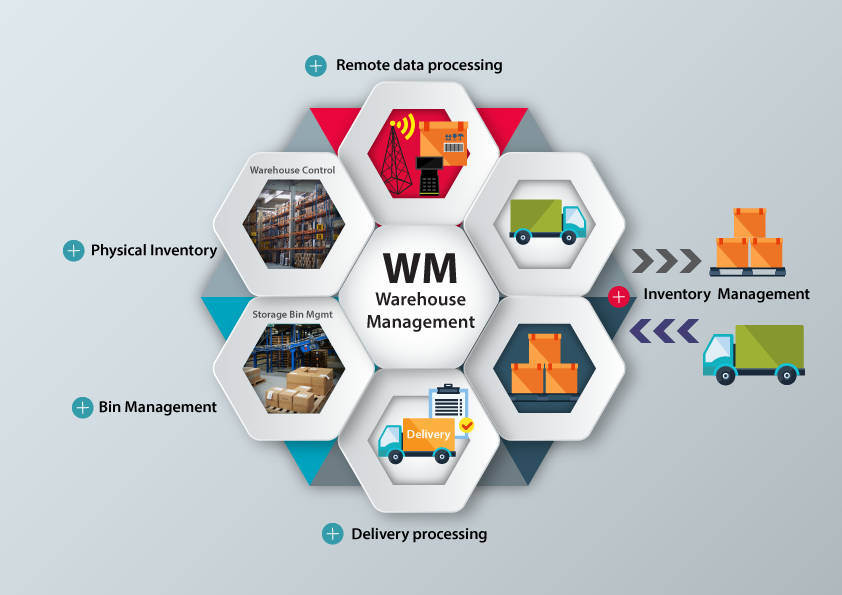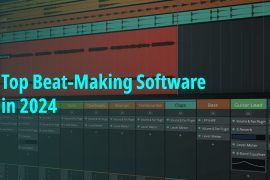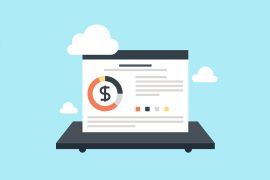Robotic Process Automation (RPA) is software that is used to build, utilize and manage software robots that match or even surpass human actions easily by communicating with digital systems and software. Robotic Process Automation (RPA) is software technology that is easy for anyone to use to automate digital tasks. With Robotic Process Automation software, users create software robots, or “bots”, that can learn, mimic, and then execute specific instructions or day-to-day actions.
Robotic Process Automation (RPA) software is emerging as a disruptive technology across industries with the capabilities of performing an immense number of operations. According to a recent report, the global market value of Robotic process automation software is expected to grow from $1.61 billion in 2021 to $7.64 billion in 2028 at a CAGR of 25% in the estimated period.
Robotic Process Automation (RPA) is a type of business process automation based on software robots or bots that perform menial business tasks to expedite enterprise operations and reduce costs. In this article, the top 5 Robotic process automation software that can be used for the benefit of mankind will be discussed. But first, it is necessary to understand what a user should look for in Robotic process automation software to ensure maximum benefit.
Table of Contents
Key Features in Robotic Process Automation Software

Following are the key features offered by Robotic Process Automation software that make it a popular platform for everyone
1. Rich analytical suite
Robotic Process Automation software comes with a rich analytical suite that discovers the performance of the robot workforce. Most enterprise-level RPA software monitors and manages automated functions from a central console. This console can be accessed from anywhere and offers basic metrics on bots, servers, workflows, and more. The complete operation analysis not only allows users to follow processes and identify problems but also aids in the simplification of future workloads.
2. Security
Robotic Process Automation software includes role-based security capability to ensure action-specific permissions. In addition, many robotic process automation software enable the configuration as well as customization of encryption capabilities for securing certain data types to defend against the interruption of network communication. The entire database, audit reports, and instructions accessed by the bot are encrypted to avoid malicious activity and ensure the legitimacy of the records and compliance.
3. Simple Bot Creation Interface
Robotic Process Automation software allows the creation of bots quickly and effortlessly by capturing mouse clicks and keystrokes with built-in screen recorder components. Many Robotic process automation software includes the option to create and edit bots manually using the Task Editor.
4. Actionable Intelligence
The actionable intelligence feature of the RPA software refers to the ability to gain and apply knowledge as skills. Robots that collect both structured and unstructured data turn the data into information, which is then transformed into actionable insight for the end-user or client. RPA systems have AI and cognitive intelligence as common aspects. It may involve machine learning, computer vision, and cognitive automation to help bots improve decision-making during crucial situations.
5. Debugging
One of the major advantages of RPA software from a development perspective is its capability to process and adjust to business operations dynamically. Some RPA software is required to stop running to make the change and replicate the process. Other RPA software allows dynamic interaction while debugging. It also allows the user to change variable values to test various situations without having to start and stop the program.
In addition to the above-mentioned features, other functionalities of robotic process automation software include:
- Source control
- Hosting and Deployment Option
- Rules-based exceptional handling
- Less script or script less automation
- Seamless integration
- Optical character recognition
- Version control
Top 5 most popular Robotic Process Automation software
Although most Robotic process automation software can be deployed for several businesses mentioned below are the top 5 Robotic process automation software that will work best as the uprising requirement of mankind.
Automation anywhere
Automation anywhere is one of the top RPA software focused on automating enterprise-grade companies from financial, public, telecom, HR, and many other sectors. Automation Anywhere provides all core capabilities. It provides on-premise and cloud services. This is an easy-to-use solution that is ideal for medium-sized businesses and large enterprises.
Attended and unattended automation, IP address processing, data processing, and compliance operations automation are the main aspects. The vendor puts a high focus on security which is why they offer a variety of security frameworks including role-based, network-based access management, and end-to-end data protection.
Most popular features
- AI/Machine Learning
- API
- Collaboration Tools
- Data Capture and Transfer
- Data Extraction
- Data Import/Export
- Real-Time Data
- Reporting and Statistics
- Provides Bank-grade security.
- Provides security through authentication, encryption, and credentials.
- Real-time reports and analytics.
- Provides platform independence.
Pros
- User-friendliness.
Cons
- IQBot needs improvement.
Pricing
Automation anywhere offers a free trial on all its subscription plans that starts at $995/year. Additional costs will be applied for the machines and the number of machines for users. Users can deploy virtually as well as on physical machines.
UiPath
UiPath is a cloud-based RPA software that assists enterprises and government organizations in streamlining their operations and repetitive administrative tasks. UiPath provides all core capabilities. It provides support for Citrix. It is user-friendly for non-developers too. It can automate complex processes and this tool is perfect for businesses of all sizes.
The key features of UiPath include a no-code/low-code development environment, compatibility with multiple coding languages (Java, Python, and VB.Net), and the built-in functionality that allows users to store licenses in a single database.
Most popular features
- API
- Access Controls/Permissions
- Alerts/Notifications
- Billing and Invoicing
- Collaboration Tools
- Compliance Management
- Document Management
- Mobile Access
- Reporting/Analytics
- Third-Party Integrations
- It can automate more quickly. Citrix also allows for eight to ten times faster automation.
- It provides an open platform.
- It can manage any number of processes, regardless of their complexity.
Pros
- No programming skills are required.
- Easy to use UI with drag and drop functionality.
- It provides good and efficient features at no cost.
Cons
- Limited coding functionality.
Pricing
The community edition of UiPath is designed for small groups and individuals. Its subscription plan starts at $3990/year.
Blue Prism
Blue Prism RPA provides all core capabilities: It may be used with any application on any platform. For using this tool users should have programming skills but it is user-friendly for developers. This tool is perfect to be deployed for medium and large-sized organizations. It is a robotic process automation program that includes a variety of features such as software robot adaptability, a side-by-side comparison of process modifications, and an automation library to assist the user in choosing which activities to automate. Since the system is based on the Microsoft.NET Framework, it is extremely dependable.
Most popular features
- It supports a multi-environment deployment model.
- In-built security tools are provided for securing network and software credentials.
- Compatible with most platforms.
- Can work for any application.
- It offers automation for on-premises, cloud, hybrid, and multi-cloud deployments.
Pros
- High-speed execution.
- Platform independence.
- Any user can design and execute process automation. They can also use the process templates offered by the platform.
- Work queue management and scaling are solid.
- Good security and compliance capabilities.
Cons
- One should have programming skills.
- Costly
- The interface design seems slightly outdated
- Google Chrome integration might cause issues sometimes.
Pricing
Its pricing is slightly higher than the other RPA software, it costs $ 15000 to $ 18000 annually. The normal license fees, as well as the installation charges, start at roughly $3,000 to $4,000.
Pega
Pega is a Business Process Management tool. It can be used on desktop servers. It provides only cloud-based solutions or services. It is compatible with Windows, Mac, and Linux and it is ideal for deployment in medium and large-sized companies. It’s a cloud-based solution that keeps all data in memory rather than a database.
Most popular features
- It will help users in the deployment of solutions.
- It provides a cloud-based solution.
- It doesn’t save any execution data in a database; instead, it stores everything in memory.
- With this tool, users can distribute the work to desktops, servers, and employees as well.
- Roll out new products, regions, or channels without copying or rewriting user applications.
- PegaA jump-starts ROI while preserving the ability to control, configure and connect as users need.
Pros
- It is more efficient due to the event-driven methodology.
- It is a dependable and durable tool.
- As everything is focused on events, the system is swift and dependable.
- To aid in its deployment, users can utilize the community forum, installation guide, or even take part in training and certifications.
Cons
- There is no on-premise solution.
Pricing
Pega plans start at $200 per month. It also provides a free trial that users can avail themselves of before making the final purchase.
Kofax
Kofax is a no-code RPA platform that automates labor-intensive multi-step operations across several data sources and platforms. AI is included in the end-to-end automation capabilities, allowing bots to analyze and act on data. These AI capabilities of Kofax also help in reducing the number of errors during document processing and data entry. Kofax can collaboratively work with any application virtually. Any specific coding skills are also not required to use this tool. Any desktop application, website, or portal can be used for data processing.
Most popular features
- It does repetitive tasks efficiently.
- Smart tool for optimizing and monitoring the processes.
- Database can be managed from a central server.
- Easy to integrate with Kapow Katalyst Platform.
- Kofax’s platform is flexible and scalable.
Pros
- Efficient tool
- Quick operation. So, it works fast.
- The no-code feature of Kofax allows users to understand and operate the software even if they do not have any advanced knowledge of coding.
- Highly flexible and easy to use.
- A broad range of capabilities support projects of any size and scope.
Cons
- Needs to improve training videos.
- It could be a little challenging to run.
- The user interface needs some improvement
- Pricing packages are slightly complicated depending on the chosen features.
Pricing
The price information of the chosen plan must be asked in the quotation. Users may also take advantage of a free trial before making a final purchase.
Conclusion
Robotic process automation software is essential software for applications, operating systems, and related equipment. It can both minimize errors and improve efficiency, and, moving forward, will be critical for creating a seamless operational environment. Repetitive tasks will be completed more quickly and effectively, allowing people to concentrate on more human-centric skills like thinking, judgment, and emotional intelligence.
RPA tools are quickly finding themselves at the forefront of driving rapid industrial growth and reshaping enterprises. It focused on cheap cost and rapid increase in accuracy and efficiency. RPA technology has a lot of promise for changing how firms function. Without a doubt, the future competency of an automated system will help every organization on the planet. RPA will continue to grow in popularity and sophistication as long as industries are looking for innovative solutions with greater ROI and reduced expense. In case you have any further questions regarding RPA and how to choose the right platform for business, you may connect with us at SaaSworthy.






